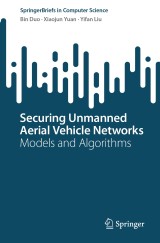Details

Securing Unmanned Aerial Vehicle Networks
Models and AlgorithmsSpringerBriefs in Computer Science
|
48,14 € |
|
| Verlag: | Springer |
| Format: | |
| Veröffentl.: | 20.11.2023 |
| ISBN/EAN: | 9783031456053 |
| Sprache: | englisch |
Dieses eBook enthält ein Wasserzeichen.
Beschreibungen
<div>This book focuses on the model and algorithm aspects of securing Unmanned Aerial Vehicle Networks (UAV). To equip readers with the essential knowledge required for conducting research in this field, it covers the foundational concepts of this topic as well. This book also offers a detailed insight into UAV networks from the physical layer security point of view.</div><div><br></div><div>The authors discuss the appropriate channel models for characterizing various propagation environments that UAV networks are exposed. The state-of-the-art technologies, such as UAV trajectory design, cooperative jamming and reconfigurable intelligent surfaces are covered. The corresponding algorithms for significantly improving the security of UAV networks, along with practical case studies on topics such as energy-efficient and secure UAV networks, elevation angle-distance trade-off for securing UAV networks and securing UAV networks with the aid of reconfigurable intelligent surfaces are presented as well. Last, this book outlines the future challenges and research directions to facilitate further studies on secure UAV networks.</div><div> </div><div>This book is suitable reading for graduate students and researchers who are interested in the research areas of UAV networking and communications, IoT security, and physical layer security in wireless networks. Professionals working within these related fields will also benefit from this book. </div>
1 Overview.- 2 Air-to-Ground Channel Modeling and Generalized Algorithms.- 3 Securing UAV Networks for Rural Areas.- 4 Securing UAV Networks for Urban Areas.- 5 Securing UAV Networks for Dense Urban Areas.- 6 Conclusions and Open Issues.
<b>Bin Duo </b>received his Ph.D. degrees in information and communication engineering from Harbin Institute of Technology, China in 2014 and from the University of Sydney, Australia, in 2016, respectively. From 2018 to 2019, he visited the Department of Electrical and Computer Engineering, National University of Singapore, Singapore. Since 2018, he has been with the National Laboratory of Science and Technology on Communications, the University of Electronic Science and Technology of China, as a Research Fellow. He is currently a Professor with the College of Computer Science and Cyber Security, Chengdu University of Technology, Chengdu, China. His research interests include convex optimization theory, UAV communications for 6G and physical layer security.<p><b>Xiaojun Yuan </b>received the Ph.D. degree in Electrical Engineering from the City University of Hong Kong in 2008. From 2009 to 2011, he was a research fellow at the Department of Electronic Engineering, the City University of Hong Kong. He was also a visiting scholar at the Department of Electrical Engineering, the University of Hawaii at Manoa in spring and summer 2009, as well as in the same period of 2010. From 2011 to 2014, he was a research assistant professor with the Institute of Network Coding, The Chinese University of Hong Kong. From 2014 to 2017, he was an assistant professor with the School of Information Science and Technology, ShanghaiTech University. He is now a professor with the University of Electronic Science and Technology of China. His research interests cover a broad range of wireless communications, statistical signal processing, and information theory including multi-antenna techniques, network coding, cooperative communications, compressed sensing, etc. He has published over 220 peer-reviewed research papers in the leading international journals and conferences, and has served on a number of technical programs for international conferences. He is now serving as an editorof IEEE Transactions on Wireless Communications, as well as of IEEE Transactions on Communications. He was a co-recipient of a number of Best Paper Awards of IEEE journals and conferences.</p>
<p><b>Yifan Liu </b>received the B.E. degree in IoT Engineering from Chengdu University of Technology, China, in 2015. He is currently pursuing his M.S. degree at Chengdu University of Technology, in the School of Electrical and Mechanical Engineering. His research interests include convex optimization theory, UAV communications, and reconfigurable intelligent surfaces.</p>
<p><b>Yifan Liu </b>received the B.E. degree in IoT Engineering from Chengdu University of Technology, China, in 2015. He is currently pursuing his M.S. degree at Chengdu University of Technology, in the School of Electrical and Mechanical Engineering. His research interests include convex optimization theory, UAV communications, and reconfigurable intelligent surfaces.</p>
<p><br></p><div><div><div> </div> </div> </div>
Provide appropriate channel models for different communication scenarios in order to secure the UAV networks Present importance of UAV trajectory design on combating malicious jamming and eavesdropping Integrate state-of-the-art technologies, such as UAV trajectory design, cooperative jamming , intelligent surfaces
Diese Produkte könnten Sie auch interessieren:

Autonomic Communication

von: Athanasios V. Vasilakos, Manish Parashar, Stamatis Karnouskos, Witold Pedrycz

149,79 €















